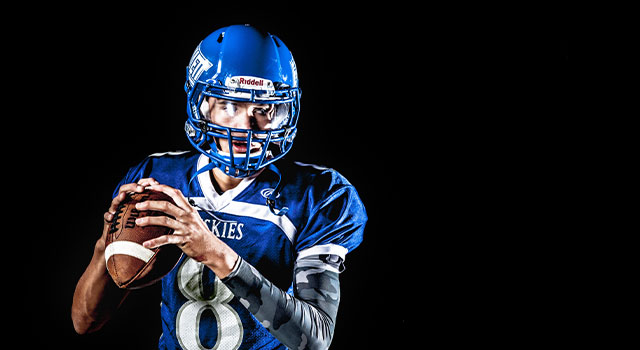 To succeed in most sports, you need to be aware of your surroundings and aptly judge distances at a glance. Luckily, these skills can be enhanced through sports vision training.
To succeed in most sports, you need to be aware of your surroundings and aptly judge distances at a glance. Luckily, these skills can be enhanced through sports vision training.
Sports vision training teaches athletes how to process what their eyes see, better and faster. It not only improves the visual skills needed to excel in your sport but also helps you stay safe by diminishing your risk of concussion and other accidents.
Sports vision training enables you to thrive in sports like football, basketball, baseball, hockey, and tennis. In fact, just about any sport!
By developing your visual skills, you'll have an easier time catching, throwing, and hitting an object. Improving your tracking, concentrating, peripheral awareness and depth perception skills can help you better gauge the distance between a basketball and the net, or the proximity of another player as you sprint to the field goal.
So it's really no surprise that sports vision training gives athletes an advantage over their opponents.
What is Sports Vision Training?
Sports vision training is a customized program that improves the communication between the eyes, body, and brain. The program is carefully formulated for your given sport and employs strategies and exercises that train the brain and body to adapt to what the eyes see more quickly and accurately.
Ways Sports Vision Training Can Help You Become a Better Athlete
Depending on your specific needs, sports vision training can improve these and many other visual skills:
1. Focusing and Tracking
Focus flexibility (also called accommodation), refers to the eyes’ ability to quickly shift focus. Improving your eye-focusing skills will help you concentrate better and refocus your vision more quickly and precisely. This will, in turn, improve your ability to process moving objects.
Convergence (or tracking) is the ability to track objects or people with eyes operating in tandem.
2. Depth Perception
Depth perception is the ability to determine the distance between yourself and other individuals or objects in three dimensions.
People with superior depth perception have an easier time gauging the exact position in 3D of an approaching object.
In fact, depth perception is one of the visual skills baseball players rely on the most to make a great catch or steal a base.
3. Peripheral Awareness
Peripheral awareness training helps you how recognize and analyze objects and people from the ‘corners’ of your eyes. Without good peripheral vision, players on the field may not perceive a ball or other players approaching them from the left or right.
No matter your sport, the sharper your visual skills, the better your performance. Contact your eye doctor to determine which of your visual skills strengthening.
Contact Visual Symptoms Treatment Center today to discover how sports vision training can help you become the athlete you'd like to be.
Visual Symptoms Treatment Center serves patients from Arlington Heights, Buffalo Grove, Northbrook, and Deerfield, Illinois and surrounding communities.
Q: Can sports vision training improve 20/20 vision?
- A: For most people, having 20/20 vision is ideal, since it gives them the excellent visual acuity they seek for daily tasks. Sports vision training, however, doesn’t improve visual acuity; it cannot make someone less nearsighted, but it can enhance the visual skills athletes need to succeed.
- Q: Who can benefit from sports vision training?
- A: Sports vision training is ideal for anyone at any age who wishes to improve their performance, in just about any sport. It’s particularly effective for athletes who play soccer, football, golf, hockey, baseball, and ping-pong — all of which involve fast-moving objects like balls and hockey pucks.
